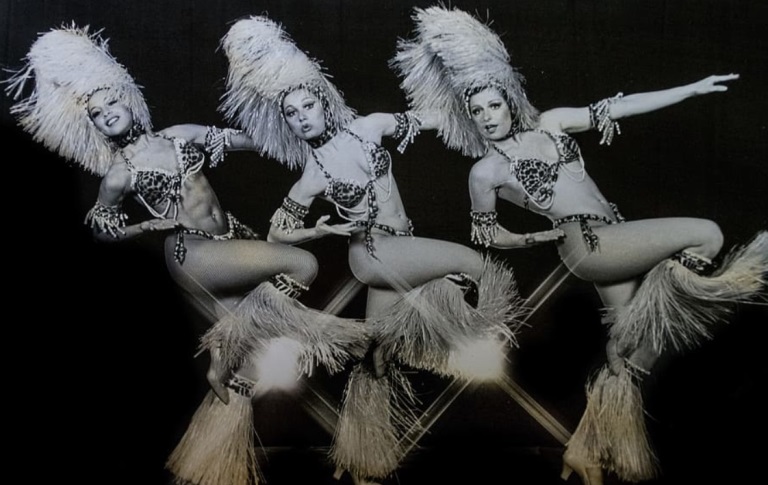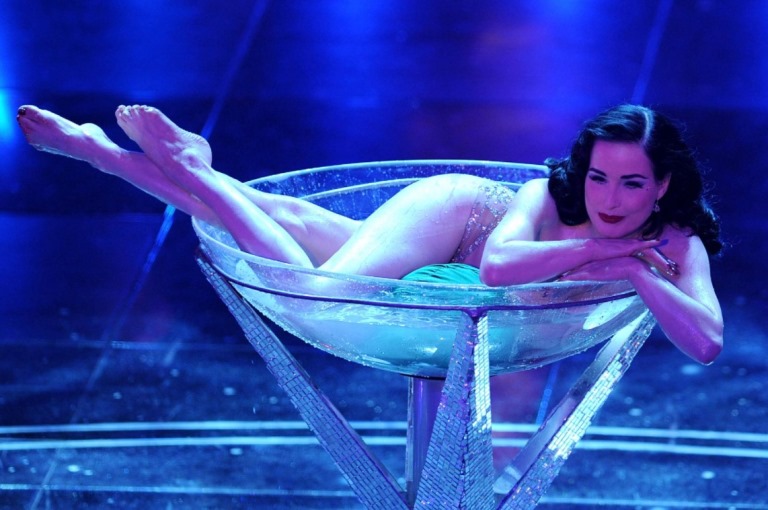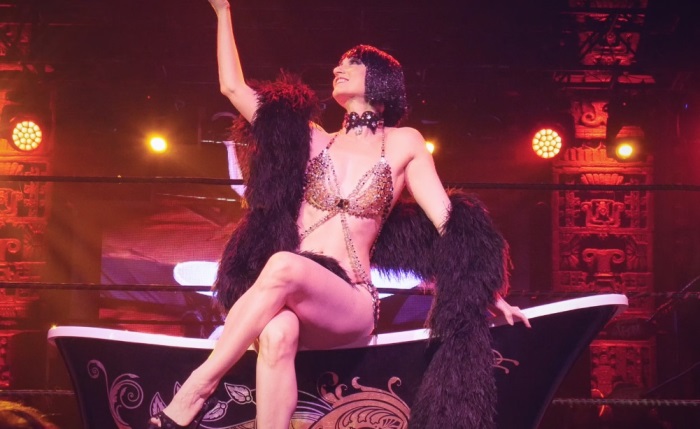The burlesque dance is often misunderstood due to its sensual and revealing nature. But when you sit in a performance yourself, you’ll soon realize that burlesque is a beautiful art form.
The dance weaves elements of comedy, vaudeville, and striptease, creating a captivating scene that you’ll be hard-pressed to find in more conventional entertainment.
So, what is the burlesque dance, really? What are its origins and history? How is it performed, and what’s up with the flashy costumes?
In this article, we’ll answer all your questions and more!
Table of Contents
What Is Burlesque Dance?
By definition, burlesque is a kind of adult-only entertainment characterized by sensual, comedic dances that actors and actresses perform in revealing costumes.
When burlesque dance history began in the 1800s, the dance was more of a “lewd comedy” than anything.
Later, it evolved into a form of striptease, where the dancer will gradually remove articles of clothes as the dance progresses up until a climactic sequence in which they remove almost everything on their body.
However, an important distinction between burlesque and stripping is that even the dancer will never get to the point of being nude. Additionally, burlesque dancers – unlike strippers – don’t dance for tips.
Burlesque Dance Origin & History
Burlesque dance, with its dazzling performances and provocative allure, has a rich and colorful history that dates back several centuries.
In the early 17th century, burlesque began as a form of musical and theatrical parody in Europe, combining lewd comedy, satire, and risqué performances.
In fact, that’s the origin of the name burlesque, derived from the Italian burlesco, from the root word of burla, meaning “to joke, ridicule,” or “mockery.”
It quickly gained popularity and evolved into a unique genre of entertainment.
Burlesques of popular romantic plays, like Shakespeare’s Midsummer Night’s Dream and Beaumont and Fletcher’s The Knight of the Burning Pestle, were staged and loved by not a small part of the public.
During the Victorian era in the 19th century, burlesque experienced a significant transformation.
Performances are now more elaborate than ever, with full-fledged costumes and more choreographed, sensual dance routines, often satirizing the social norms and conventions of the time.
The genre became closely associated with vaudeville and variety shows. Burlesque shows started to attract a more diverse audience.
Burlesque continued to evolve through the 20th century, bolstered even further by the rise of American pop culture and the advent of motion pictures.
Many historians consider the period between the 1920s and 1930s the “Golden Era of Burlesque,” characterized by glamorous striptease acts and elaborate stage productions.
Renowned performers like Gypsy Rose Lee and Sally Rand stole stages everywhere and – while a section of the public wasn’t quite happy with their non-conforming and risqué performances that were considered indecent and “socially unacceptable” at the time – another part of the public was truly in love with burlesque and their performers.
Unfortunately, as society’s values shifted, burlesque faced a decline in the mid-20th century. Stricter regulations, alongside the rise of other forms of entertainment, saw it being phased out.
So, is burlesque still around in the 21st century?
Yes! Although not in as great a scale as before. There are still many burlesque shows on offer at nightclubs.
But more importantly, burlesque is no longer an “artist-only” thing. Dance and fitness studios now offer burlesque classes, embracing body-positive and joyfulness.
So, if you’re interested, you can become a burlesque dancer!
Burlesque Dance Moves: How To Dance
Burlesque is not a complex dance. You don’t need to take dozens of classes to learn the basics.
There are plenty of burlesque dance moves you can try out right now from the comfort of your home!
Hip Bopping
Bopping the hip is an easy way to get started. It’s super easy to do.
- Stand straight with your arms down on either side of your body.
- Bend one knee on your dominant leg and keep the toes of the foot on the ground.
- Bring your hip up and down to the rhythm of the background music.
- As you move your hip, rock your hip up and down to create a “bopping” motion.
- To exaggerate the bopping motion, bring one hand onto the hip that’s bopping.
- Switch to the other side once you’ve done one cycle.
Shimmy
The shimmy will move your top, while hip bopping uses your lower body. Push one of your shoulders up toward your ear, then bring it down to the rhythm of the music. Alternating each side to make a shimmying motion.
As you move your shoulders, introduce an undulating motion with your upper body by rocking your chest back and forth.
You should also open up your arms, bending at the elbows. The arms will maintain your balance and give you an inviting look.
Grind
Start by moving your hips in a circular motion while engaging your glute muscles (the muscles in your buttocks). Imagine drawing circles with your hips from the front to the back.
When your hips are in front of you, tighten your glutes and pull your stomach in. As you bring your hips behind you, relax your glutes and stomach.
You can either keep your hands on your hips or open your arms and gently roll your wrists as your hips move.
Here’s a helpful tip: Picture yourself wearing a hula hoop around your hips and try to follow its circular shape!
Strut
The strut is very simple. It’s an exaggerated catwalk!
Practice walking forward with your toes pointed, one leg crossing the other, and your hips swaying to the motion.
Keep your shoulders and back straight and your chest lifted.
Time your walk to the rhythm of the music so that your pace and hip-swaying are all on the beat.
If you have a mirror with you, the pose that you can make will be extremely sexy and empowering!
Hair Flip
- Bring one of your legs to the front, keeping it straight with your toes pointed.
- Then, bend your body forward so your hair hangs from your head. Your arms should run smoothly down your legs until your hands can grip your ankles.
- Then, with a powerful movement (that should best be timed to the music), bring your chest upward so that your hair flips from the ground and springs to the air.
Of course, dancers with long hair should best make this dance move. But for those with shorter hair, it can also be a very captivating and sexy move to do as well!
Burlesque-style Turn
- Make a single stride forward, then twirl your body as you walk.
- Once you’ve finished a single turn, bring your dominant foot forward with the toes pointed at the ground.
- With your toes pointed, quickly bring your knee upward, then down again, almost as if you’re teasing the floor with the point of your toes.
Arch and Swirl
- Begin by standing with your legs slightly wider than shoulder-width apart.
- Bend forward at the hips as if reaching for something on the floor while keeping your legs straight.
- Slowly rise back up, running your hands up your legs as you do. Once upright, swirl your hips to the side, facing the audience.
Remember to maintain a straight back throughout the movement.
Leg Crossover
The leg crossover is a fun and engaging way to start dancing with props (which is a mainstay of many burlesque routines). For the leg crossover, you only need a chair.
- Begin by standing beside a chair and crossing one leg before the other, keeping your ankles close together.
- Lean forward at your hips, placing your palms on the chair seat, ensuring your legs and back remain straight.
- Next, bend one knee and kick that leg out behind you in a circular motion. Bring your foot back to the ground and cross your legs again.
- Repeat these leg kicks, alternating between legs. This creates a stylish impression.
Remember to keep your toes pointed and maintain graceful kicks.
Check more: What Is Haka Dance? Origin, Costume & Facts
Burlesque Dance Costumes
Burlesque dance costumes are crucial in any routine.
When selecting your costume, opt for playful and eye-catching attire that stands out. Consider incorporating elements like leotards, corsets, lingerie, or two-piece outfits that feature shiny, glittery, or attention-grabbing designs.
To enhance your costume, embrace accessories like adding flowers to your hair, and wear large statement earrings.
If you have the budget or want to go all-out, consider incorporating capes and feather boas. You can draw inspiration from burlesque icons like Gypsy Rose Lee for your costume.
When it comes to burlesque dance shoes, stilettos, and pumps are popular choices for burlesque heels, adding elegance and height to your performance.
If your routine involves stripping, ensure that your chosen clothing allows for easy and smooth removal during your dance. You can seamlessly transition and captivate the audience with your reveal.
Burlesque Dance Music
Traditional burlesque-style performances often incorporate jazz or big band songs. These genres are deeply rooted in the history of burlesque and provide a classic and sensual atmosphere.
Look for songs with captivating beats that align with your favorite moves and resonate with your personal style.
But while jazz and big band genres are popular for traditional burlesque, remember that the key is to select music that makes you feel sexy and confident while allowing you to showcase your dance skills.
So, for example, if you feel more at home dancing to more modern music, don’t hesitate to try! It’s not rare for contemporary performances to feature pop or EDM music.
Notable Burlesque Dancers
Over the years, there have been dozens of burlesque dancers who have become veritable sex icons.
Here are a few famous burlesque dancers worth checking out.
Dita Von Teese
The influence of Dita Von Teese, born Heather Renée Sweet, is so significant that she is widely recognized as the “Queen of Burlesque”.
Although she originally aspired to be a classical ballerina, Dita’s path took a surprising turn when she visited a strip club at 19. She was unimpressed by the lack of originality in the performances she witnessed.
One of her standout acts involves bathing in a grand cocktail glass surrounded by glistening crystals.
This act has become synonymous with Dita and adds an extra layer of mesmerizing spectacle to her performances.
Gypsy Rose
Gypsy Rose Lee, born Rose Louise Hovick, initially began her career as an ordinary dancer and singer. However, she soon discovered she could be much more by embracing riskier dances.
Gypsy focused less on the explicit “strip” element and more on the art of the tease. This turned her performances into mind games rather than simple strip teases.
A true luminary of her time, Gypsy’s talents extended beyond her dancing abilities. With two novels and a play, she’s shown herself to be an excellent writer.
Additionally, she hosted various television shows and starred in numerous films. Her extensive filmography garnered critical acclaim, leading to her receiving a well-deserved star on the Hollywood Walk of Fame.
Michelle L’amour
Michelle L’amour, born on April 15, 1980, in Orland Park, Illinois, is one of today’s most famous American neo-burlesque performers.
She gained national attention in 2006 when she was featured on NBC’s America’s Got Talent and Showtime’s Sexual Healing.
With her signature tagline, “The Ass That Goes POW!” Michelle has become renowned for her captivating performances.
Michelle’s journey in the world of dance began at age 15 when she studied various dance styles, including ballet, jazz, hip-hop, modern, and lyrical.
At 22, she delved into a burlesque striptease and quickly made a name for herself.
In 2005, Michelle earned the prestigious title of Miss Exotic World, impressing the judges with her Snow White routine.
Continuing her success, Michelle appeared on the French show “France got talent” in November 2012, advancing to the semi-finals.
Alongside her performances, Michelle L’amour established Studio L’amour in June 2008, a renowned burlesque instruction school that catered to the growing demand for her unique teaching method.
Michelle L’amour’s captivating novelty acts have graced various television programs, including Fox’s A Current Affair and MSNBC’s The Situation with Tucker Carlson.
With her talent, passion, and dedication to the art of burlesque, Michelle L’amour continues to leave an indelible mark on the industry.
Margaret Hart Ferraro
Margaret Bridget Bryan, known professionally as Margie Hart, was born in Edgerton, Missouri, on September 28, 1913.
Leaving home at 16, she pursued studies in “exotic dancing” once she came of age in St. Louis.
Margie was part of many social movements revolving around burlesque during the 30s and 40s. She was arrested in April 1935, along with two other burlesque dancers, for giving an indecent performance at Minsky’s Burlesque.
Despite the arrest, they were later freed by Magistrate Guy Van Amringe in May 1935. Her arrest coincided with a campaign against burlesque in New York City, leading to temporary closures of establishments like Minsky’s.
In 1942, Hart appeared in the Broadway show “Wine, Women, and Song,” which combined vaudeville, burlesque, and Broadway revue elements.
The show included striptease, causing controversy and ultimately leading to its closure in December 1942.
Margie Hart passed away in 2000 in Los Angeles.
Final Words
Burlesque, as you can see, is a lot more than just stripping.
Though critics may have lots of words to talk about its risqué nature, there’s no denying that artists like Gypso Rose and Michelle L’amour have demonstrated just how liberating and pure fun it can be to perform and watch.
We hope this guide to burlesque has been insightful for you!
What’s your favorite aspect of burlesque? Tell us in the comments!




